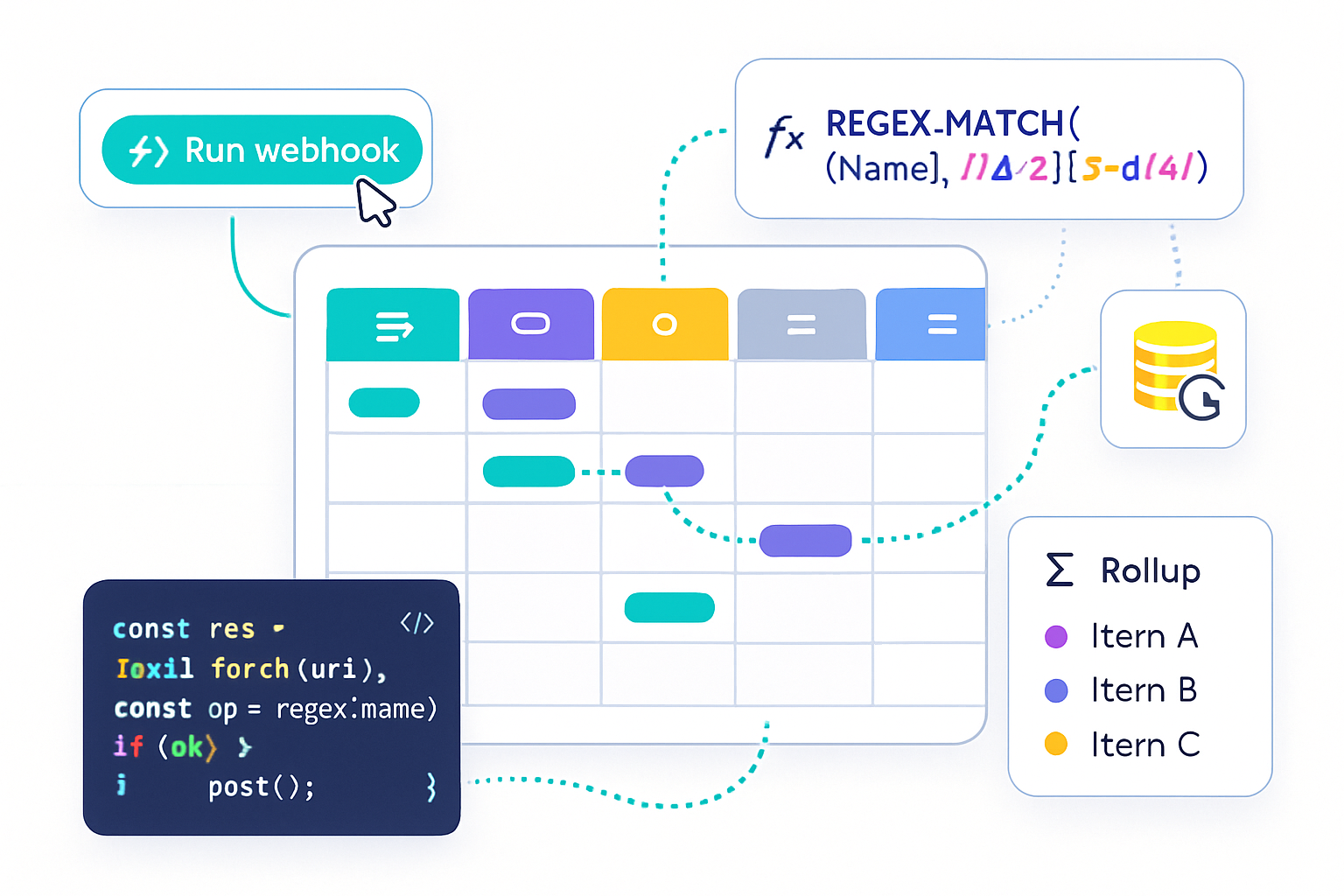· productivity · 6 min read
10 Smartsheet Hacks You've Never Heard Of
Ten lesser-known Smartsheet hacks - from advanced cross-sheet formulas and clever helper columns to automation tricks, Card View tweaks, and API/webhook ideas - to streamline workflows, improve collaboration, and boost productivity.

Introduction
Smartsheet is full of obvious wins - sheets, reports, dashboards, and automations - but it also hides clever, workflow-changing tricks that many users never discover. Below are 10 practical, lesser-known Smartsheet hacks you can apply today to reduce manual work, tighten collaboration, and surface better insights.
Hack 1 - Use INDEX(COLLECT(…)) as a cross-sheet lookup (VLOOKUP replacement)
Problem: You need a reliable lookup across sheets but Smartsheet’s VLOOKUP has limitations.
Hack: Use INDEX with COLLECT to return the first match (or build a list). It’s more flexible and works well with cross-sheet references.
Example formula (in a cell on your target sheet):
=INDEX(COLLECT({ReturnRange}, {LookupRange}, [LookupValue]@row), 1)How to implement:
- Create cross-sheet references to the columns you need (Insert > Reference Another Sheet).
- Replace {ReturnRange} and {LookupRange} with those cross-sheet references and [LookupValue]@row with the lookup value on this row.
Why this is useful: COLLECT filters a range by conditions; INDEX picks the first (or nth) match. This pattern is robust when the lookup key isn’t uniquely positioned and lets you combine multiple criteria with additional COLLECT arguments.
Reference: https://help.smartsheet.com/articles/2476148-collect-function and https://help.smartsheet.com/articles/2476197-index-function
Hack 2 - Aggregate matching entries into a single cell with JOIN + COLLECT
Problem: You want an at-a-glance list of all related items (e.g., all tasks assigned to a client) instead of scanning many rows.
Hack: Use JOIN and COLLECT to combine matching cell values into a comma-separated (or custom-delimited) string.
Formula example:
=JOIN(COLLECT({Task Name Range}, {Client Range}, [Client]@row), ", ")Notes:
- This returns all matching Task Name values for the client in the current row.
- Use a different delimiter (“\n”) to create multi-line values - useful if you export or display in a dashboard widget.
Reference: https://help.smartsheet.com/articles/2476157-join-function
Hack 3 - Build dynamic hyperlinks to rows and external systems using concatenation
Problem: You need quick access to a specific Smartsheet row or to generate a URL to a ticket in another system.
Hack: Build dynamic links with the row URL and string concatenation.
How to get a row URL:
- Right-click the row and choose “Create Row Link” (or copy row URL from the row’s menu) to understand the pattern.
- Build a formula like:
=HYPERLINK("https://app.smartsheet.com/b/home?lx=" + [UniqueID]@row, "Open Row")Or generate external links:
=HYPERLINK("https://jira.example/browse/" + [Ticket ID]@row, "Open JIRA")Pro tip: Combine with JOIN/COLLECT to create a single link that opens a pre-filtered view or an external search.
Reference: https://help.smartsheet.com/articles/2485735-creating-links-in-smartsheet
Hack 4 - Use Card View + Symbol columns to create a lightweight Kanban with automations
Problem: You need a Kanban-style board but don’t want to license a separate tool.
Hack: Use Card View and create Symbol columns (Priority, Blocked, etc.) to represent swimlanes or visual cues. Then pair with automations to move rows between sheets or update statuses automatically.
Steps:
- Add a Symbol column and set your icons (flag, stoplight, check, etc.).
- Switch to Card View and set the grouping to Status or another column.
- Create automations (e.g., when Status changes to Done, move row to an Archive sheet).
Why it works: Card View plus Symbol columns gives you visual prioritization and the automations keep your board clean and maintain an audit trail.
Reference: https://help.smartsheet.com/articles/2485843-card-view
Hack 5 - Create “helper” columns for easier filtering, sorting, and automation
Problem: Complex formulas or filters are hard to reuse and maintain.
Hack: Use helper columns that store intermediate values (e.g., normalized dates, concatenated keys, computed risk scores). Use these helper columns as simple conditions in filters and automations.
Examples:
- Normalized priority - =IF(CONTAINS(“urgent”, LOWER([Notes]@row)), “High”, “Normal”)
- Composite key for matching - =TRIM([Client]@row + ”|” + [Project ID]@row)
- Urgency window - =IF([Due Date]@row < TODAY() + 3, “Immediate”, “Normal”)
Benefits:
- Makes filters and automation rules readable.
- Keeps formulas modular and easier to debug.
Reference: Smartsheet formula documentation https://help.smartsheet.com/articles/2476192-formula-functions
Hack 6 - Save sheet layouts as templates and preserve conditional formatting + automations
Problem: Recreating the same sheet layout across projects is time-consuming.
Hack: Use Save as Template to clone entire sheets including column types, conditional formatting and automations. Create a “project blueprint” template with helper columns, form, and automation baked in.
Steps:
- Set up your sheet with columns, conditional formatting, forms, and automation rules.
- File > Save as Template.
- When creating a new project, select the template - the structure and automation come with it, so you only tweak project-specific data.
Note: Some linked items (like cross-sheet references or cell links) will need re-linking or updating.
Reference: https://help.smartsheet.com/articles/2476168-creating-templates
Hack 7 - Archive rows automatically (move row) to keep sheets performant
Problem: Large sheets become slow; you want to keep history without cluttering active views.
Hack: Use automation to Move Row when a Status changes or when a date passes. Create a dedicated archive sheet that stores completed records.
Example automation flows:
- When Status changes to “Complete”, move row to “Project Archive” sheet.
- When [Completed Date] is older than 365 days, move row to Archive.
Why this matters: Keeps active sheets fast, preserves old data in a structured place, and maintains row-level audit history.
Reference: https://help.smartsheet.com/articles/2485728-automation-overview
Hack 8 - Use conditional formatting rules with formulas for granular control
Problem: The standard conditional formatting rules don’t capture complex business logic.
Hack: Use formula-based conditions in conditional formatting to evaluate multi-column logic.
Common patterns:
- Highlight rows where Due Date is within 3 days and Status is not Done:
=AND([Due Date]@row <= TODAY() + 3, [Status]@row <> "Done")- Flag inconsistent data (e.g., Start Date after End Date):
=[Start Date]@row > [End Date]@rowHow to apply:
- Format > Conditional Formatting > New Rule > Use a formula to determine which cells to format.
Reference: https://help.smartsheet.com/articles/2476192-formula-functions
Hack 9 - Leverage cell history + comments for lightweight audits and reversions
Problem: You need to confirm when a value changed or who changed it, and sometimes revert.
Hack: Right-click a cell and use View Cell History to see edits, timestamps, and user IDs. You can copy a previous value and paste it to restore. Use comments for contextual discussion that persists with the row.
When to use:
- Disputes about when a status changed.
- Recovering accidentally deleted text.
Reference: https://help.smartsheet.com/articles/2476159-view-cell-history
Hack 10 - Trigger external workflows with webhooks and the API (near real-time integrations)
Problem: You want to integrate Smartsheet events with external systems (Slack, BI tools, custom services) in near real-time.
Hack: Use Smartsheet webhooks (or automation integrations) to notify your service when a sheet changes. Pair that with a small middleware (Azure Function, AWS Lambda, or serverless endpoint) to route events to Slack, create tickets, update systems, or push to a data warehouse.
High-level flow:
- Create a webhook (via API) that subscribes to sheet events.
- The webhook posts to your endpoint when a row is added/changed.
- Your service parses the payload and triggers whatever downstream action you need (e.g., post a Slack message, call a 3rd-party API, update a database).
Resources and starter kits:
- Smartsheet API docs and Webhooks: https://smartsheet.redoc.ly/
- If you prefer no-code, pair Smartsheet with Zapier or Power Automate to bridge systems without writing middleware.
Why this is powerful: Webhooks let you act on changes instantly - perfect for incident escalation, sync with CRMs, or powering custom dashboards.
Reference: Smartsheet API and developer docs https://smartsheet.redoc.ly/
Final tips to get these hacks into your workflow
- Start small - pick 1–2 hacks that address your biggest pain points (e.g., auto-archiving + helper columns).
- Document your template - add a README sheet inside project templates to explain helper columns and automations for teammates.
- Test automations in a copy of the sheet before enabling in production.
- Use cross-sheet references sparingly - they’re powerful but can make templates harder to copy if references point to fixed sheet IDs.
If you try just a couple of these - dynamic join/lookups, helper columns, and automatic archiving - you’ll already notice fewer repetitive tasks and cleaner project sheets. Happy Smartsheet hacking!



